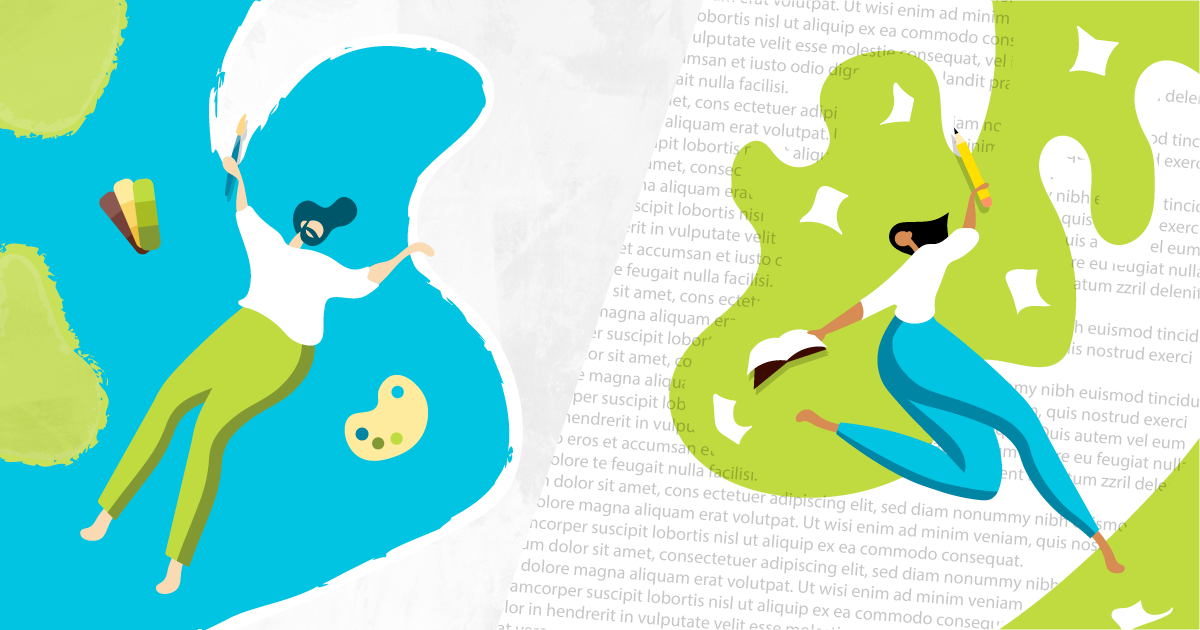The Great Agency Debate: Should Copy or Design Come First?

Copy then design? Design then copy? I was first posed with this dilemma in college, as a freshman journalism major working on the plan for the semester’s inaugural newspaper. My goal was to be a writer, but as a student reporter, we had to learn print layout, too.
This is where I was introduced to InDesign, discovered what kerning was and learned that a pica was a legitimate unit of measurement. Newspaper layout was not my calling, but it did give me an appreciation for design and how it brought copy to life.
Which brings me to the age-old agency question asked of both copywriters and designers alike — what comes first: copy or design? It’s an important question because it gives you an idea of workflow, but it also lets you know what is valued in any given project. Has the client gotten excited about a particular design element or functionality? Then there’s a chance copy will have to be adjusted to make it work. Is there a quick turnaround time? Copy and design will probably have to work in conjunction to make the date.
There are also considerations to be made for medium. Is this a print project? Is it a website or an app? Are you creating a social campaign? It’s clear that the way copy and design are approached varies case by case, but I believe it’s still a discussion worth having. I wanted to know, from both copywriters and designers, which should come first — and what’s more, why it should be that way.
First, some of our copywriters share their thoughts.

Julie Marateck, Sr. Copywriter/Content Strategist
When it comes to this question, it's like the chicken or the egg. I mean, you can't have one without the other — both copy and design have to work in tandem. I'd say that copy should inform design — and not just because I'm a copywriter. Words inform visuals, even in our daily life. If you are talking to a friend, the words being spoken are what inspires which images play out in your head. In a technical sense, word count can impact the design of a website. Words are the core of communication, and visuals are what bring them to life.

Meghan Smith, Associate Director of Content
The idea should happen first. To me, ideally, writers and designers will brainstorm and concept together. It doesn't matter who comes up with the idea — the best idea wins. From there, both can work on their parts separately with one solid idea or concept as the guide. Frequent check-ins and collaboration are ideal. Basically, I think it should be a team effort and not a chicken or the egg type of thing.

Anna Morgan, Director of Content
Ideally, I think copy and design would align first, then tackle their respective roles, but that's not always possible. I could probably go on and on waffling about this, but one thing that I'd totally feel comfortable going on record saying: The best copywriters have an eye for design. They might not be able to photoshop the thingy to be more "bold” or whatever, but they can give the kind of feedback that improves the overall deliverable — and give that feedback in a way that doesn't encroach on a designer's mojo.
Similarly, the best art directors and designers understand good copy, and can edit headlines for the sake of the overall idea — not just for the sake of design or character limits. Being able to creative direct from both sides is what makes the most powerful creative teams — and sometimes that means abandoning the standard "A should come before B" process, and being open to something new that may work even better.

Chelsie Rivera, Senior Copywriter
That's a trick question: Neither the copy nor design comes first — the concept comes first! I love an art and copy concepting session where we can shape the big picture before getting started. First of all, there are some great undercover copywriters in the design department who help shape the copy. Plus, getting on the same page from the beginning makes it easier for copy and design to work in tandem, which helps the project move more quickly.
And now, let’s hear from a few of our Nebo designers.

Lety Macedo, Interactive Designer
I think copy always helps inform the design. Without copy, without figuring out what you’re going to say, the design becomes design for design’s sake. Like decoration. Having a strategy or something to inform, that’s what makes design better. Design should help make the messaging better, not compete with it. Without copy, it’s kind of like a guessing game.
If you design and copy comes after, you end up having to change a lot to accommodate it. So you end up doing double the work. Sometimes, for things like magazine design or posters, the visual direction comes first because you’re trying to bring them in by creating a bigger picture with design and then get them to look at the copy.

Kory Gabriel, Art Director
Copy can be a constraint that helps design. Otherwise, you could tinker as long as you want without knowing what the final word count or phrase is. You can kind of spin your wheels, design something that's really nice, but when copy comes along, you have to revamp all the type styles or the layout itself. In a lot of cases, constraints make the design achievable. When you have rules, you know what you can play with. When there are no rules at all, you’re kind of paralyzed. You’re like, “Where do I go from here? Where do I even start?”
There are some projects where copy and design working together and brainstorming has come up with really great outcomes. It’s not always one or the other. For larger ideas, those brainstorming sessions where we come together set us up for a more successful project.

Susie Kim, Interactive Designer
Copy gives you an idea of what it’s about, content-wise. Design-wise, it affects the arrangement of text and how design fits together. Having copy first is more convenient for designers. Obviously if the copy and design teams understand each other and how they work, it’ll help the overall process. I’ve had moments where I’ve thought, “This copy can be trimmed,” or “It would be better if it were worded like this,” but I still think people should specialize. You don’t need to be a great writer to be a great designer. It helps to understand each other and have some experience, but it’s not necessary.

Mo' Safavynia, Art Director
I look at copy blocks like shapes and other objects to design around. In starting design, knowing how much copy there’ll be or how big it’ll be, that’s ideal. I like to know how much to plan for. I think it’s important because copy restrictions give me a reason to do certain things. There’s a reliance on “this shouldn’t get any bigger because I’m planning this nice little package.” I think that’s also where we can work together. I’m fine with leaning on copy, just like copy leans on design.

Mathew Shamloo, Associate Creative Director
Sometimes, I like copy to come first so I know what I’m designing. Other times, I just want to design it, see what it looks like, and then we can cut the copy and put it in there. I don’t always prefer it one way. I do think copy is an essential part of design. Text can be the design. It’s not always a pattern or a texture or a photo.
Having constraints is a part of design, and understanding that as a designer, you should be able to see copy and say, “That looks a little long, can we shorten that?” For copywriters, it helps to know how something is going to fit or wrap to a third line. Or even knowing to have a consistent typecase or whether something will have punctuation in the design. I think you have to have some awareness of one or the other. Copywriters should have an idea of what something will look like in design.
The Verdict
There were nuances to each response, but it would appear that most of Nebo agrees: if we have to choose, copy comes first. Hearing everyone’s perspective was enlightening, but also validating. As a writer, I’ve always admired what our design team does to bring words and ideas to life. To hear designers whose work I admire say they need copy to inform their work — well, that’s just really damn cool.
What’s cooler than that is the value that we all put on collaboration. If I had to answer this question myself, I’d say that copy and design should work together as much as possible, wherever possible — especially in the early stages of a project. Another perspective I hadn’t even considered before exploring this question was the idea that an overlap of skills could also strengthen the relationship between copy and design, and in turn, our deliverables.
Does that mean designers should also be copywriters and vice versa? No. But it would seem we all agree there should be an understanding, and even a respect, for what both teams do. And, if you zoom out even further, you might notice that what we both do isn’t all that different in the end. Kory, an interactive designer here at Nebo, said it best:
“I think that you have to be a little bit of a communicator, in general, to be a copywriter or a designer. You have to know that you’re trying to achieve a message, whether you think visually or verbally first, and you have to have an idea of how it comes together. I think you need some kind of mish-mash of skills in your wheelhouse to be able to create optimally.”
Comments
Add A Comment